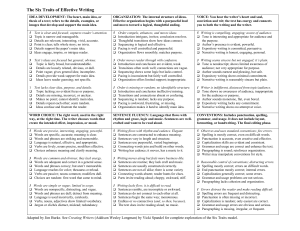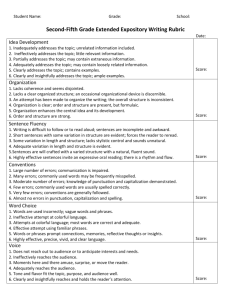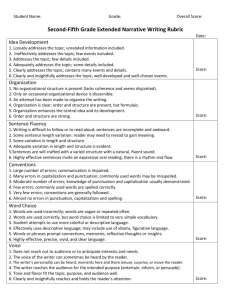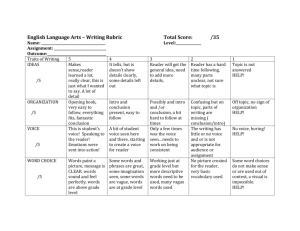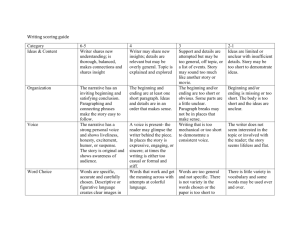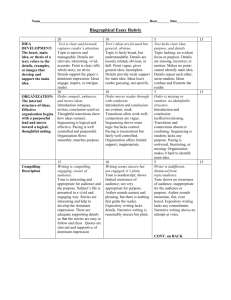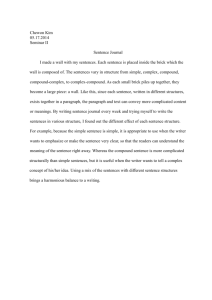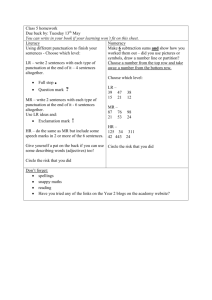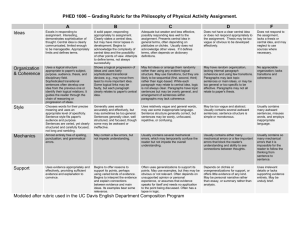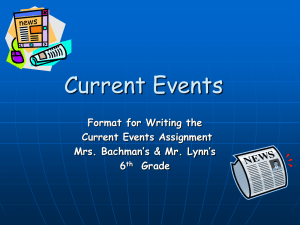Six Traits of Writing: Personal Narrative Rubric
advertisement
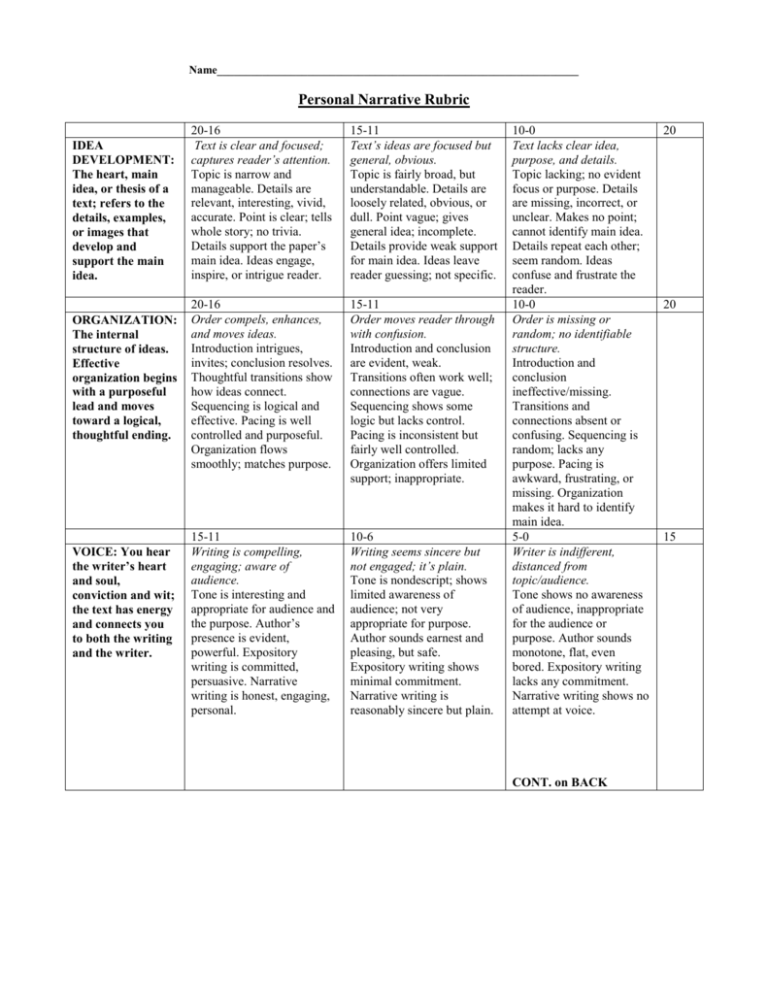
Name________________________________________________________________ Personal Narrative Rubric IDEA DEVELOPMENT: The heart, main idea, or thesis of a text; refers to the details, examples, or images that develop and support the main idea. ORGANIZATION: The internal structure of ideas. Effective organization begins with a purposeful lead and moves toward a logical, thoughtful ending. VOICE: You hear the writer’s heart and soul, conviction and wit; the text has energy and connects you to both the writing and the writer. 20-16 Text is clear and focused; captures reader’s attention. Topic is narrow and manageable. Details are relevant, interesting, vivid, accurate. Point is clear; tells whole story; no trivia. Details support the paper’s main idea. Ideas engage, inspire, or intrigue reader. 15-11 Text’s ideas are focused but general, obvious. Topic is fairly broad, but understandable. Details are loosely related, obvious, or dull. Point vague; gives general idea; incomplete. Details provide weak support for main idea. Ideas leave reader guessing; not specific. 20-16 Order compels, enhances, and moves ideas. Introduction intrigues, invites; conclusion resolves. Thoughtful transitions show how ideas connect. Sequencing is logical and effective. Pacing is well controlled and purposeful. Organization flows smoothly; matches purpose. 15-11 Order moves reader through with confusion. Introduction and conclusion are evident, weak. Transitions often work well; connections are vague. Sequencing shows some logic but lacks control. Pacing is inconsistent but fairly well controlled. Organization offers limited support; inappropriate. 15-11 Writing is compelling, engaging; aware of audience. Tone is interesting and appropriate for audience and the purpose. Author’s presence is evident, powerful. Expository writing is committed, persuasive. Narrative writing is honest, engaging, personal. 10-6 Writing seems sincere but not engaged; it’s plain. Tone is nondescript; shows limited awareness of audience; not very appropriate for purpose. Author sounds earnest and pleasing, but safe. Expository writing shows minimal commitment. Narrative writing is reasonably sincere but plain. 10-0 Text lacks clear idea, purpose, and details. Topic lacking; no evident focus or purpose. Details are missing, incorrect, or unclear. Makes no point; cannot identify main idea. Details repeat each other; seem random. Ideas confuse and frustrate the reader. 10-0 Order is missing or random; no identifiable structure. Introduction and conclusion ineffective/missing. Transitions and connections absent or confusing. Sequencing is random; lacks any purpose. Pacing is awkward, frustrating, or missing. Organization makes it hard to identify main idea. 5-0 Writer is indifferent, distanced from topic/audience. Tone shows no awareness of audience, inappropriate for the audience or purpose. Author sounds monotone, flat, even bored. Expository writing lacks any commitment. Narrative writing shows no attempt at voice. CONT. on BACK 20 20 15 WORD CHOICE: The right word, used in the right way, at the right time. The writer chooses words that create the intended effect, impression, or mood. SENTENCE FLUENCY: Language that flows with rhythm and grace, logic and music. Sentences are well crafted and want to be read aloud. 15-11 Words are precise, interesting, engaging, powerful. Words are specific, accurate; meaning is clear. Words and phrases are striking and memorable. Language is natural, effective, and appropriate. Verbs are lively, nouns precise, modifiers effective. Choices enhance meaning and clarify meaning. 10-8 Writing flows with rhythm and cadence. Elegant. Sentences are constructed to enhance meaning. Sentences vary in length and structure. Sentences use purposeful, varied beginnings. Connecting words join and build on other words. Writing has cadence; it moves, has music to it. 20-16 CONVENTIONS: Includes punctuation, spelling, grammar, and usage. It does not include layout, formatting, or handwriting. The final editing phase. Observes and uses standard conventions; few errors. Spelling is mostly correct, even on difficult words. Punctuation is accurate, even creative and effective. Capitalization skills are evident and consistent. Grammar and usage are correct and enhance the text. Paragraphing is sound, reinforces organization. Writer may manipulate conventions for style. 10-6 Words are common and obvious; they lack energy. Words are adequate and correct in a general sense. Words and phrases convey, but aren’t memorable. Language reaches for color; thesaurus overload. Verbs are passive, nouns common, modifiers dull. Choices are random: first word that came to mind. 5-0 Words are simple or vague; limited in scope. Words are nonspecific, distracting, and vague. Words and phrases are dull, detract from meaning. Language is used incorrectly, carelessly. Verbs, nouns, adjectives show limited vocabulary. Jargon or clichés distract, mislead; redundancy. 15 7-4 Writing moves along but feels more business-like. Sentences are routine; they lack craft and music. Sentences are usually constructed correctly. Sentences are not all alike; there is some variety Connecting words absent; reader hunts for clues. Parts invite reading aloud; choppy, awkward, stiff. 15-11 3-0 Writing lacks flow; it is difficult to read. Sentences ramble, are incomplete or awkward. Sentences do not connect to each other at all. Sentences begin the same way; monotonous. Endless or no connectives (and, so then, because). The text does invite reading aloud; no music. 10-0 10 Reasonable control of conventions; distracting errors. Spelling mostly correct; errors on difficult words. End punctuation mostly correct; internal errors. Capitalization generally correct; some errors. Grammar and usage problems are not serious. Paragraphing lacks cohesion and organization. Errors distract the reader and make reading difficult. Spelling errors are frequent and distracting. Punctuation is often missing or incorrect. Capitalization is random, only easiest are correct. Grammar and usage errors are obvious and serious. Paragraphing is missing, irregular, or frequent. 20 Total Grade /100
